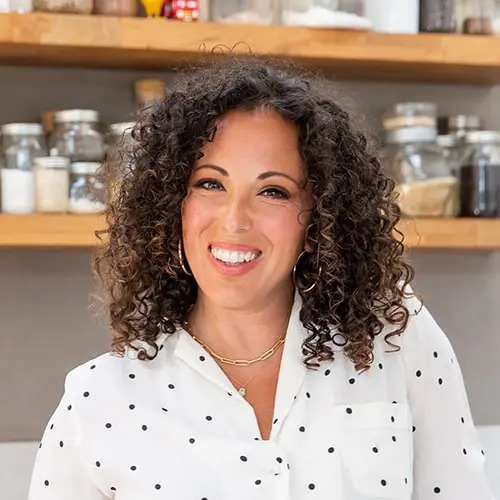Everyone is gathered around the holiday table eating pumpkin pie. But not you. You know how you’ll feel after eating it.
Bloated.
Your tummy will hurt.
Lots of gas.
Maybe your skin will break out or start itching or you’ll be overwhelmed by fatigue.
Such a beautiful-looking pie and you can’t even have a bite. You sigh. It’s like the culinary equivalent of the Grinch Who Stole Christmas. You’re a mean one, Mr. Pie.
And the problem isn’t just the pumpkin pie. It’s all the carbs served with a traditional holiday dinner.
That’s how my patient, who I’ll call Jane, felt. When she first arrived in my office, she dreaded Thanksgiving and the holidays. She knew that if she touched any of the sweet treats or high-carb foods she’d pay the price.
That was until I pinpointed the root causes of her problem. Now, she actually looks forward to the holidays because she can indulge in the edible offerings of the season while still feeling healthy and well.
Yes, it’s possible. How did we do it? And how can you get rid of bloating, abdominal pain, gluten intolerance and more? You’ll discover the answers to these questions and more in this blog post.
A Frustrating Time in Jane’s Life
When Jane first arrived in my office in 2019, she was 12 weeks pregnant with her fourth child. She was having a super hard time and needed relief asap.
For starters, she was exhausted. She’d been pregnant or breastfeeding for the last seven years. She also homeschooled all of her children.
Her tummy hurt, she had near-constant gas, she was bloated and constipated. As if that wasn’t enough fun, she also had gnarly acne, painful canker sores, and regularly itchy ears, scalp, arms, and legs. Her eyes often crusted over in the morning.
She had been barely getting by eating a basic diet. She could only eat clean proteins with olive oil and salt along with above-ground veggies. If she ate anything else her symptoms flared. She couldn’t eat starches and only a little, if any, fruit. Eating nuts gave her canker sores.
As you can imagine, she dreaded Thanksgiving and the holidays. She couldn’t eat turkey if the brine had even a little sugar in it. She couldn’t have stuffing, even if it was gluten-free. And forget about anything high-carb.
No mashed potatoes and gravy. No grains. No dairy.
Can you relate?
Nothing Seemed To Work For Good
It had been six years since she felt “good.” Back then, she was on the Gut and Psychology Syndrome (GAPS) diet. This type of diet addresses the connection between the gut and brain and is often used to heal the gut. It includes meat, fish, eggs, fruit, non-starchy vegetables, and fermented foods.
But Jane had to stick with the GAPS diet religiously, and even then some of her symptoms lingered. After being on the diet, her digestion wasn’t painful anymore and she stopped catching every cold and flu that went around, but she still suffered from daily bloating and constipation.
Jane’s problems actually dated back to before the age of 10. Back then, she had frequent tummy pain. Her parents took her to the doctor a bunch of times, but no one could figure out what was wrong.
In college, doctors put Jane on the drug Accutane for her acne. If I had a dollar for every patient of mine who told me this was part of their history! Accutane devastates the gut microbiome and detoxification. The gut microbiome is the collection of bacteria, both good and bad, that live in your intestines and tune your metabolism, brain, gut health, and immune system.
Even worse, doctors make women take birth control while on Accutane because it can cause birth defects. The birth control sends women into a state of estrogen dominance, which only makes their problem worse.
Not surprisingly, Jane’s stomach pain got worse over the years. In her early 20s, Jane went on a gluten-free diet and the pain went away for a while. But it ultimately came back.
The First Red Flag
During our first appointment, Jane mentioned she had a front-loading washer. It smelled musty and she’d seen mold in it. Gross, right?
In her old house, the washer was in the basement and she could leave the door wide open to reduce the mold. Now the washer was on the main floor in her new house and there was foot traffic, so she had to keep the door closed. The musty smell grew worse.
Helpful hint: get rid of your front-loading washer, like yesterday!
The presence of the moldy washer led me to order a mycotoxin test, which identifies toxins from mold. The result? Jane had HUGE amounts of a type of toxin known as ochratoxin, which are produced by some Aspergillus species of black mold.
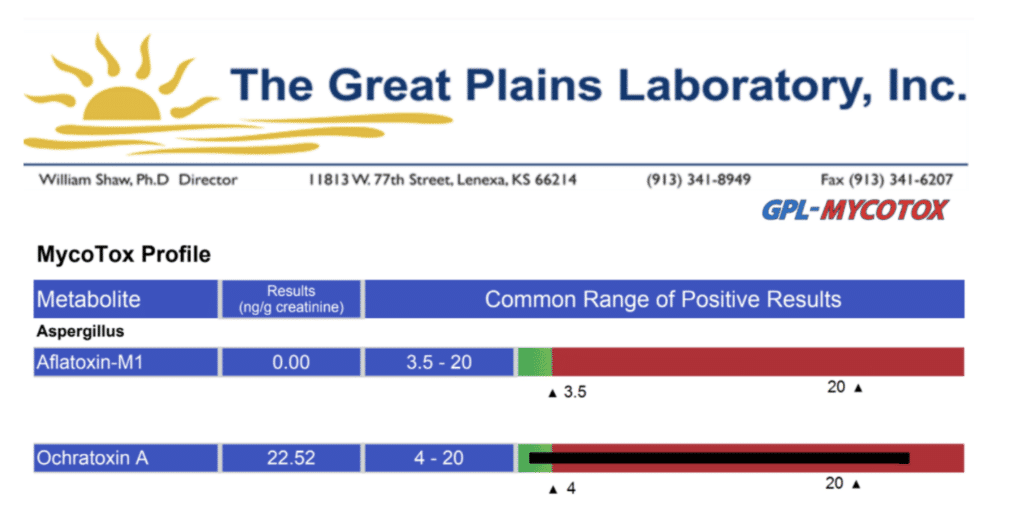
Other tests I ordered were:
- GI-MAP stool panel, which detects parasites, bacterial and viral dysbiosis, and Candida
- Organix panel, which identifies nutrient deficiencies and metabolic imbalances
- Small-intestinal bacterial overgrowth (SIBO) breath test, to determine if she had SIBO, a condition where there is an abnormal increase in the bacteria population of the small intestine, which can cause diarrhea, weight loss, and malnutrition. Jane actually requested this test, after reading about SIBO symptoms in a blog post I had written.
A Trio of Test Results
The GI-MAP stool test revealed Jane had an amoeba parasite called Dientamoeba fragilis, which can live in the large intestines of people. This little bug often causes no symptoms, but in some people it can lead to diarrhea and abdominal pain, as well as loss of appetite, nausea, and fatigue.
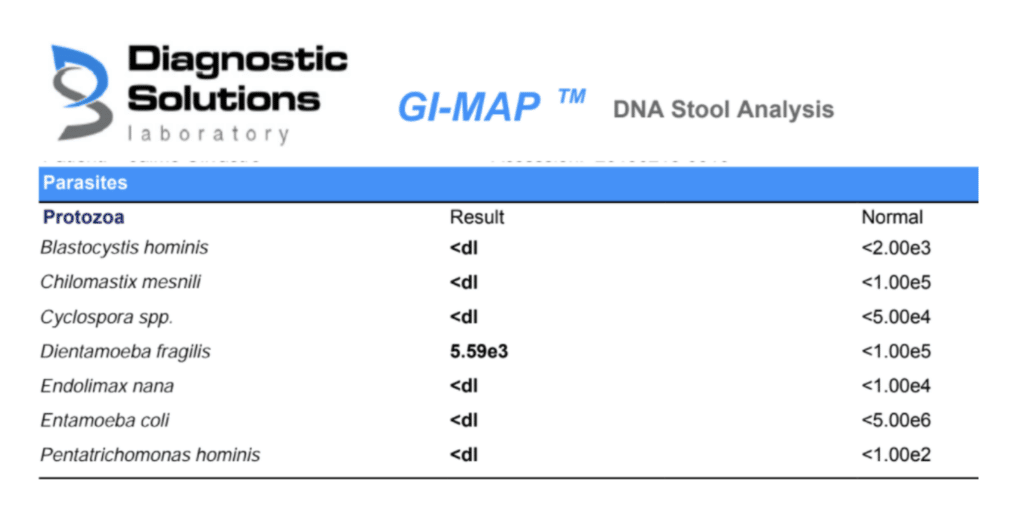
Jane’s Candida levels were through the roof. And her SIBO test came out positive. She had a type of SIBO known as methane dominant (IMO). This type of SIBO is caused by an overgrowth of single-celled organisms called archaea. It can cause constipation as well as bloating and gas.
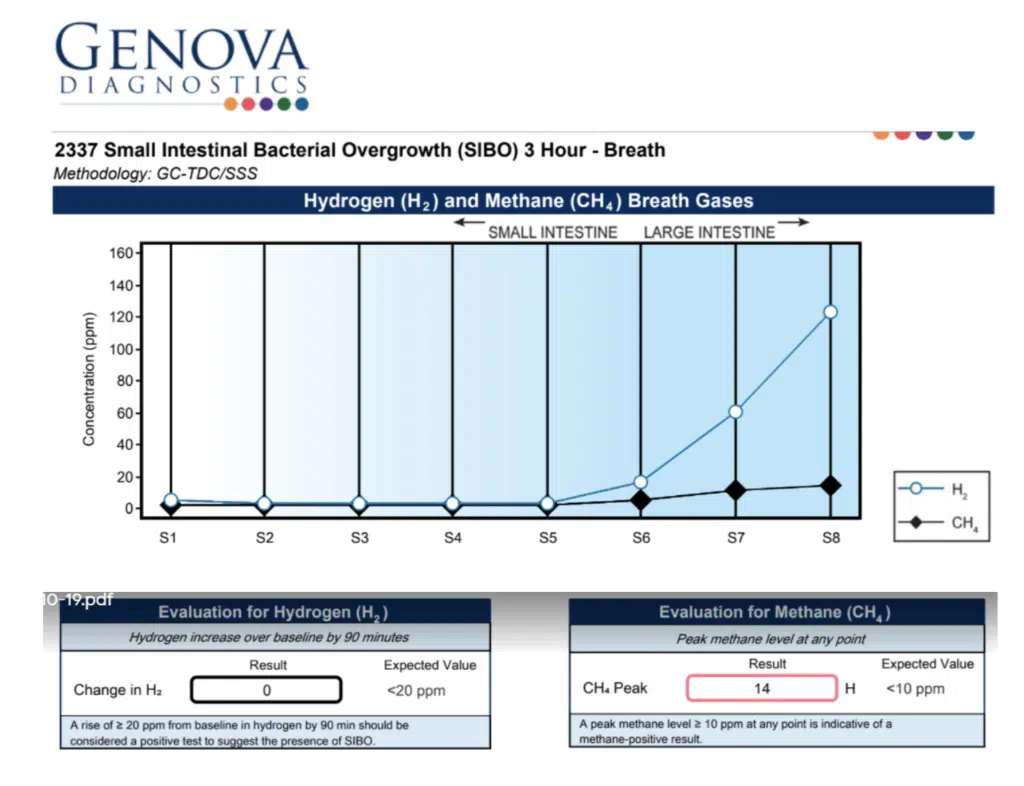
And what about Jane’s Organix test? That showed she was deficient in some nutrients. She needed B vitamins, especially vitamin B6.
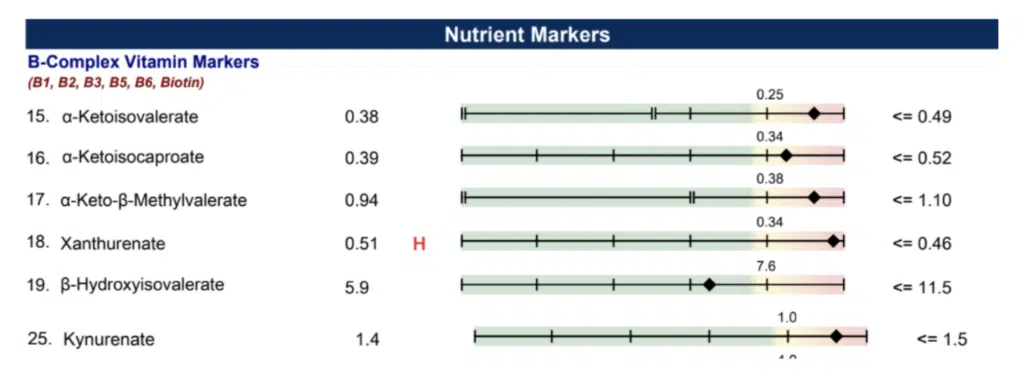
Helping a Pregnant Jane Feel Better
In most patients I would have treated the mycotoxin right away, but because she was pregnant I had to put the brakes on that approach. Otherwise, the mold could end up in her breast milk as she was detoxifying.
Until she finished nursing, I decided to focus more on healing her gut and resolving her gut symptoms. Here’s what I did at first:
- I gave her enzymes and hydrochloric acid to improve her digestion. I gave her some nutrients and herbs to help her with constipation.
- I put her on a low-FODMAP diet for the short term, but only because she was in such extremely bad shape. If you’re pregnant, don’t try this type of diet at home! It’s hard to follow this diet and get all the nutrients you need for you and the baby. You need a trained practitioner to supervise. However, for Jane, it reduced her symptoms and it was only for a short period, so it was worth it!
- I had her take several supplements including L-glutamine to heal the gut and butyrate and probiotics to balance her gut microbiome. I also gave her gentle herbs to reduce gas and bloating and encourage more frequent and complete bowel movements. For example, she used stone root (Collinsonia), a safe and effective way to promote better BMs in pregnancy.
- Suggested she avoid electromagnetic fields (EMFs) for the health of her and her baby. She noted that this dramatically shifted her symptoms in a short time.
Taking the Next Step to Feeling Well Again
After Jane finished nursing we went after her parasite first. Jane started doing coffee enemas and taking anti-parasitic herbal supplements. At the same time, I wanted to make sure she was making healthy amounts of bile, so I gave her phosphatidylcholine and a liver-supporting supplement known as TUDCA.
Next, we went after the mold toxins. I had her take supplements to detoxify her body of the Aspergillus mycotoxin. These included liposomal glutathione, binders specific to the mycotoxins she showed on her tests, antioxidants, and Quinton liquid, which helps transport toxins out of cells. I also suggested she have mold remediation done on her home. And aha! As I suspected, the problem went beyond the front-loading washer: the remediator found mold in the home’s air ducts.
This wasn’t an overnight treatment. She needed two rounds of the anti-mold supplements, three months per round, with retesting in between.
At the same time, Jane continued to work on healing her gut. She took digestive enzymes, L-glutamine, and Tributyrin-X™, a postbiotic butyrate supplement that promotes gut health, heals the intestinal walls, and encourages regular bowel movements.
At this point, as treatment unfolded, she had less indigestion and gas.
Getting rid of the mold was HUGE!
Things were looking up—but they still weren’t perfect.
Digging Deeper to Heal the Gut
Jane began an anti-Candida protocol. But those stubborn little fungi refused to be beaten.
I decided to retest her gut. And guess what showed up to the party? She was infected with high levels of two critters: C. difficile and H. pylori.
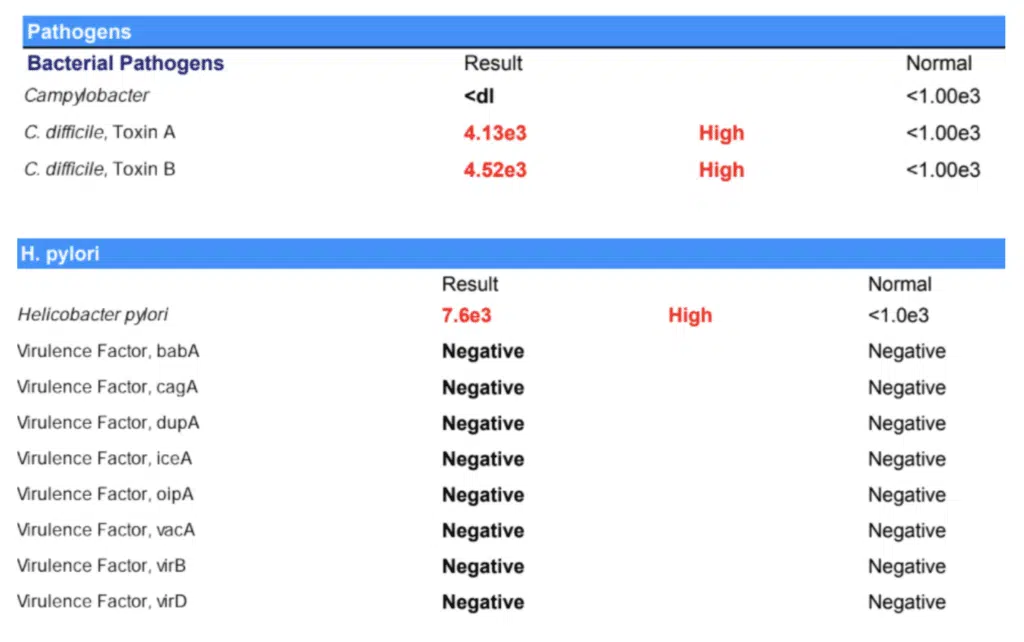
She’d probably picked up these bacteria after taking antibiotics for persistent diarrhea and fever during an earlier pregnancy with her third child. The antibiotics made the diarrhea and fever go away but she developed bronchitis. And guess what? The doctor gave her more antibiotics and she developed a vaginal infection. This was probably because the antibiotics caused a flare-up of the Candida. She was given yet more antibiotics. All that during pregnancy!
H. pylori and Candida often go hand in hand. As I’ve written about before, they often work as a team, so getting rid of one helped get rid of the other. Likewise, I have seen that C. difficile always exists in tandem with Candida overgrowth.
In order to tackle the C. difficile and H. pylori, we put the mold treatment on intermission. Once we got rid of these two bacteria, her symptoms were better. And she could finally say goodbye to her Candida overgrowth.
To address the vitamin B6 deficiency showing up in her Organix panel, she started supplementing with this nutrient. Vitamin B6 is important for brain development and keeping the nervous system and immune system healthy. Vitamin B6 plays an important role in the immune system of the intestines. The friendly flora of the gut also need vitamin B6 and other B vitamins to do their job well.
Take a look at her follow-up results for ochratoxin A. So much better! More importantly, this was associated with her symptom reduction. I always look at lab results in the context of how the patient is feeling. This is as much- or more- important than what we see on lab results!
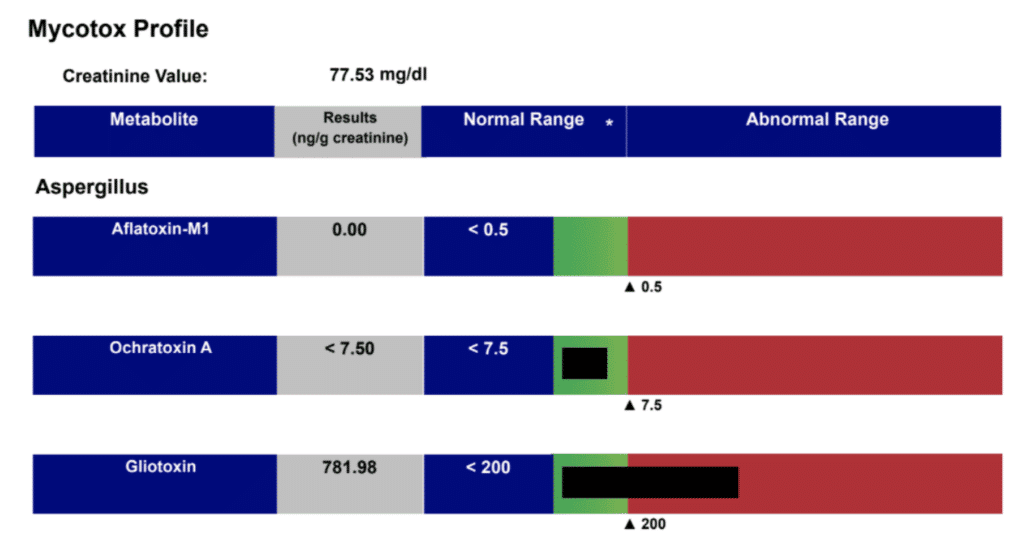
This whole process isn’t an overnight fix. It can take nine months or more. This is especially true for people like Jane who have had mycotoxins, bacteria, and other harmful organisms in their gut for a long time. Jane had symptoms almost her entire life. The longer you’ve been infected, the longer it may take to heal.
Be persistent!
Moving forward, we will focus on gut repair while nourishing and rebuilding Jane’s microbiome. We will support her detoxification processes for at least six months and maybe more.
Jane Doesn’t Have To Deprive Herself Anymore
Today, Jane is feeling amazing. She can tolerate a lot more foods. She no longer gets canker sores when she eats nuts. And what about her bloating, constipation, and abdominal pain? Virtually all gone!
Thanksgiving and the holiday season are now something Jane looks forward to for the first time in years. Her body can handle stuffing, potatoes, and pumpkin pie.
It’s the same on a daily basis. Within reason, Jane can tolerate less-than-perfect foods without going into a downward spiral.
Keep in mind that this journey is different for each person. Not everyone with food sensitivities can go back to eating a spectrum of allergenic foods in quick time. And some people may have to avoid a certain allergen for life because it harms their bodies. However, in general, when we improve gut health, people can resume eating foods (in moderation) that previously sent them into a tailspin.
Eat The Foods You Love Again
Do you have food sensitivities, gluten intolerance, or digestive symptoms like bloating, abdominal pain, and gas? You don’t have to live with these forever. Like Jane and I did, you and I can work together to unearth the root cause of your problem. I’ll help you eat your favorite foods again and feel healthier while you’re doing it. Your path to better gut health begins with a free 15-minute troubleshooting call.
At the Reverse-Age Method, we believe in a holistic approach to perimenopause and beyond, that addresses the root causes of your symptoms (like insomnia, hot flashes, night sweats, erratic periods, fatigue, skin aging, weight gain, and brain fog)– to also slow the pace that your cells are aging. Whether it’s improving gut health, optimizing detox function, enhancing mitochondrial function, or building muscle mass, our comprehensive program has got you covered.
If you’re new here, be sure to check out our Blog Page for more insights and tips on how to thrive during perimenopause. Our blog is packed with practical advice, success stories, and the latest research to help you on your journey.
For more updates and community support, follow us on social media:
You May Also Like...
Top 3 Uses for This Amazing Probiotic Yeast
In the world of natural health, yeasts get a bad rap. But one of my favorite probiotics, Saccharomyces boulardii, is…
Will Using Hormone Replacement Therapy Help Me Lose Weight?
Hormone Replacement Therapy (HRT) is often the first line of defense women consider when they experience the upheaval…
Whether you’re looking for help with your gut, your hormones, or both, our team of practitioners work together to treat the WHOLE you – guiding you to a healthier mind, body, and spirit day by day.

